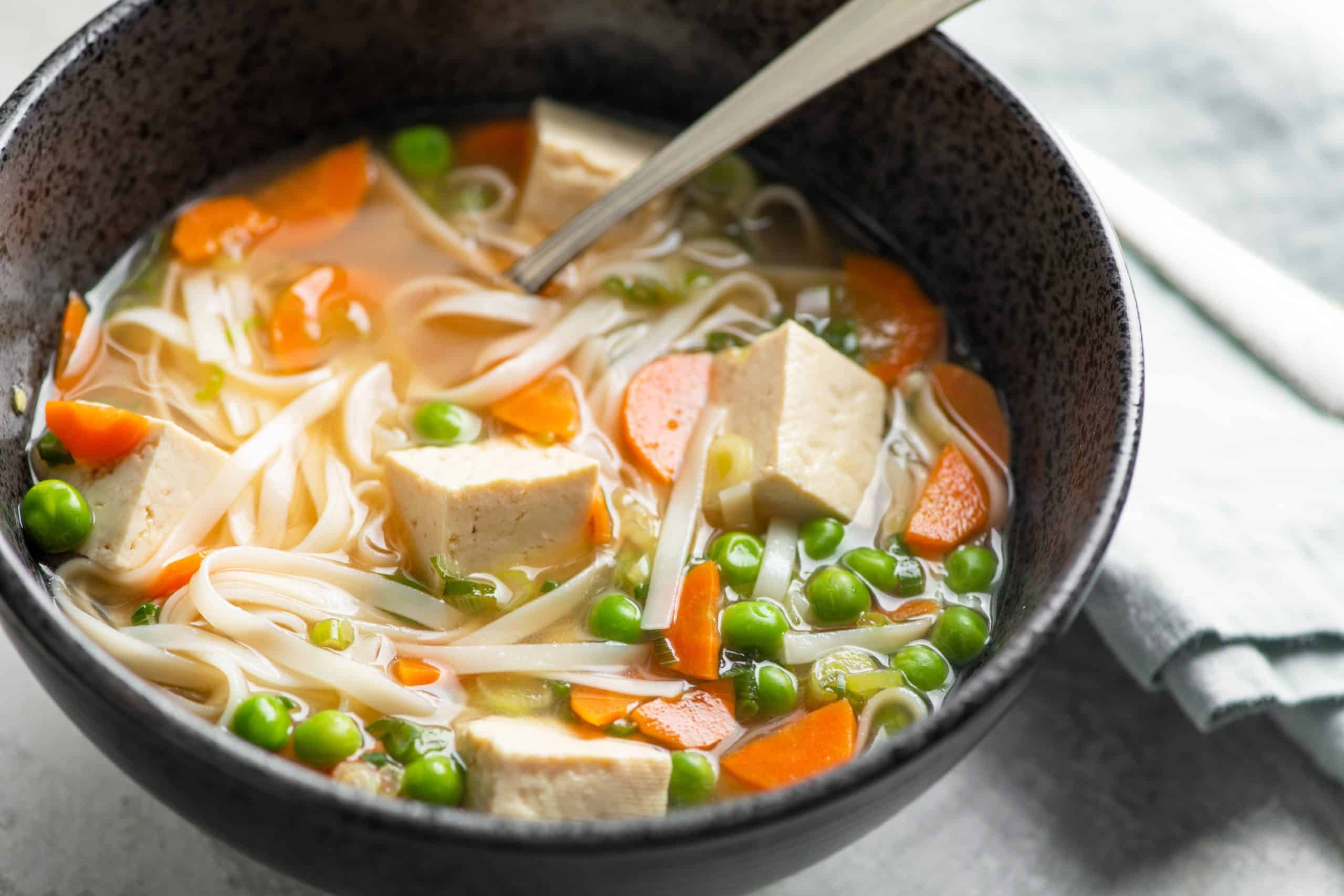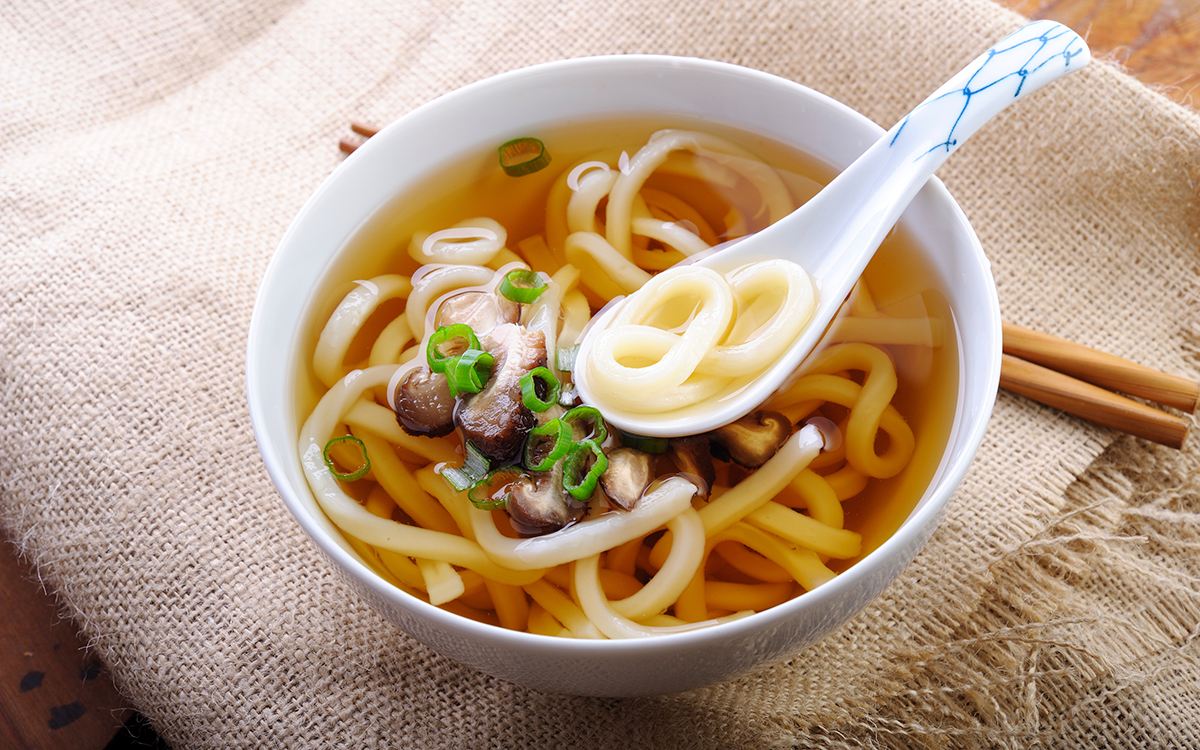Indulge in the culinary delights of Japan with udon mee soup, a comforting and versatile dish that tantalizes taste buds and warms the soul. This delectable soup features thick, chewy udon noodles swimming in a flavorful broth, adorned with an array of toppings that add layers of texture and flavor.
From the intricacies of selecting the perfect noodles to mastering the art of crafting a savory broth, this guide will equip you with the knowledge and techniques to create an authentic and unforgettable udon mee soup experience in the comfort of your own kitchen.
Udon Noodle Varieties
Udon noodles come in various forms, each offering unique textures and flavors. Understanding the differences can help you choose the best type for your dish.
Fresh Udon Noodles
Fresh udon noodles are soft, chewy, and have a slightly translucent appearance. They are typically made from wheat flour, water, and salt, and are available in various thicknesses and shapes, such as flat, round, or square. Fresh udon noodles are commonly used in soups, stir-fries, and tempura dishes.
Dried Udon Noodles
Dried udon noodles are made from the same ingredients as fresh noodles but are dehydrated to extend their shelf life. They have a firmer texture than fresh noodles and require rehydration before use. Dried udon noodles are widely available in Asian grocery stores and can be found in various shapes and sizes, including bundles or individual strands.
Frozen Udon Noodles
Frozen udon noodles are a convenient option for those who want to have noodles on hand without worrying about spoilage. They are typically par-cooked and frozen, resulting in a texture that is slightly softer than fresh noodles but firmer than dried noodles.
Frozen udon noodles can be thawed and used in various dishes, making them a versatile and time-saving option.
Essential Ingredients for Udon Mee Soup

The ingredients for a basic udon mee soup recipe are simple and readily available. Here’s a list of the essentials:
Udon Noodles
Udon noodles are thick, chewy Japanese noodles made from wheat flour. They come in various thicknesses and shapes, such as flat, round, or square.
Dashi Broth
Dashi broth is a Japanese stock made from kelp and bonito flakes. It forms the flavorful base of the soup.
Soy Sauce
Soy sauce adds a salty and umami flavor to the soup. Use a good quality soy sauce for the best taste.
Mirin
Mirin is a sweet Japanese rice wine that adds a touch of sweetness and complexity to the soup.
Sugar
A small amount of sugar helps balance the flavors and round out the soup.
| Ingredient | Measurement |
|---|---|
| Udon Noodles | 1 package (300g) |
| Dashi Broth | 4 cups |
| Soy Sauce | 1/4 cup |
| Mirin | 1/4 cup |
| Sugar | 1 tablespoon |
Broth Options
Udon mee soup’s broth is a crucial element that enhances the overall flavor and experience. Various broth options exist, each offering distinct characteristics.
- Dashi: This is the most common broth used in udon mee soup. It is made from a combination of kombu (kelp) and katsuobushi (dried bonito flakes). Dashi has a light, delicate flavor with umami notes.
- Shoyu: This broth is made by adding soy sauce to dashi. It has a slightly salty and savory flavor, making it a popular choice for those who prefer a bolder taste.
- Miso: This broth is made by adding miso paste to dashi. It has a rich, earthy flavor with a slightly sweet undertone. Miso broth is a good option for those who want a hearty and flavorful soup.
| Broth Type | Flavor | Texture |
|---|---|---|
| Dashi | Light, delicate, umami | Clear, slightly viscous |
| Shoyu | Salty, savory | Clear, slightly thicker than dashi |
| Miso | Rich, earthy, slightly sweet | Thick, creamy |
The choice of broth depends on personal preference and the desired flavor profile. Dashi provides a versatile base that complements various toppings and ingredients. Shoyu adds a savory depth, while miso offers a hearty and comforting flavor.
Variations and Adaptations
Udon mee soup, with its versatile nature, has undergone regional variations and adaptations throughout its culinary journey. Different cultures have left their mark on this dish, shaping its flavors and ingredients.
Regional Variations
*
-*Kagawa Prefecture (Sanuki Udon)
Known for its thick and chewy udon noodles, served with a light soy sauce-based broth.
-
-*Nagano Prefecture (Shinshu Udon)
Features flat and wide noodles, often served with a broth made from miso or dashi.
-*Aichi Prefecture (Kishimen)
Offers flat, wide noodles cut into thin ribbons, served in a clear broth with toppings like green onions and tempura flakes.
Cultural Influences
*
-*Korean Influence
The Korean dish “udong” is similar to udon mee soup, but uses wheat flour noodles instead of rice flour. It is often served with a spicy broth.
-
-*Chinese Influence
The Chinese dish “lamian” is a type of pulled noodle soup that has influenced the development of udon mee soup. The noodles are typically hand-pulled and served in a savory broth.
-*American Influence
In the United States, udon mee soup is often served with toppings such as fried chicken, tempura shrimp, or vegetables.
Cooking Techniques

Mastering the art of cooking udon mee soup requires meticulous attention to each step of the process.
Every stage plays a crucial role in achieving the perfect balance of flavors, textures, and aromas that define this iconic dish.
Prepping the Ingredients
Before you begin cooking, it’s essential to prepare all the ingredients carefully. Rinse the udon noodles thoroughly to remove excess starch, then drain them well. Slice the vegetables and proteins into uniform pieces to ensure even cooking. Measure out the seasonings and sauces accurately to achieve the desired taste profile.
Cooking the Noodles
Bring a large pot of salted water to a boil. Add the udon noodles and cook according to the package instructions, stirring occasionally to prevent sticking. The cooking time may vary depending on the thickness and type of noodles used.
Once cooked, drain the noodles immediately and rinse them under cold water to stop the cooking process and prevent them from becoming mushy.
Preparing the Broth
While the noodles are cooking, prepare the broth. In a separate pot, combine the dashi stock, soy sauce, mirin, and sake. Bring the mixture to a boil, then reduce the heat and simmer for at least 15 minutes to allow the flavors to meld.
Adjust the seasonings to taste, adding more dashi for a richer flavor or soy sauce for a saltier broth.
Assembling the Soup
Once the noodles and broth are ready, it’s time to assemble the soup. In a large bowl, place the cooked noodles. Top with the vegetables, proteins, and any other desired toppings. Pour the hot broth over the ingredients, ensuring that everything is evenly submerged.
Garnish with green onions, nori strips, or a sprinkle of seven-spice powder for an authentic touch.
Serving and Enjoying
Serve the udon mee soup immediately, while it’s hot and steaming. Enjoy the harmonious blend of flavors and textures as you savor each spoonful. The chewy noodles, tender vegetables, and rich broth will create a symphony of flavors that will tantalize your taste buds and warm your soul.
Presentation and Serving Suggestions
Udon mee soup is typically served hot in a large bowl. The noodles are arranged in the center of the bowl, and the broth is poured over them. The soup is then garnished with a variety of toppings, such as green onions, tempura, or kamaboko (fish cake).
Udon mee soup is often served with a side of rice or pickles.
Enhancing Presentation
There are a few things you can do to enhance the presentation of your udon mee soup. First, make sure the noodles are cooked to perfection. They should be soft and chewy, but not mushy. Second, use a flavorful broth.
The broth should be rich and savory, with a hint of sweetness. Third, choose toppings that will add color and texture to the dish. Green onions, tempura, and kamaboko are all popular choices.
Serving Options and Accompaniments
Udon mee soup can be served as a main course or a side dish. It can also be served as a snack or a light meal. Udon mee soup is often served with a side of rice or pickles. Other popular accompaniments include tempura, edamame, and gyoza.
Last Word
Whether you prefer the simplicity of a classic udon mee soup or enjoy experimenting with regional variations, this guide has provided you with the essential knowledge and inspiration to embark on your culinary journey. Embrace the flavors and textures of this beloved Japanese dish, and savor the satisfaction of creating a homemade meal that will transport your taste buds to the heart of Japan.
FAQ Corner
What is the difference between fresh, dried, and frozen udon noodles?
Fresh udon noodles are soft and have a slightly chewy texture, while dried udon noodles have a firmer texture and a longer shelf life. Frozen udon noodles are a convenient option, but they may have a slightly different texture than fresh or dried noodles.
What are the essential ingredients for udon mee soup?
The essential ingredients for udon mee soup include udon noodles, dashi broth, soy sauce, mirin, and sake. Additional ingredients, such as vegetables, meat, and tofu, can be added to enhance the flavor and texture of the soup.
What are the different types of broth used in udon mee soup?
The most common types of broth used in udon mee soup are dashi broth, shoyu broth, and miso broth. Dashi broth is a light and flavorful broth made from kelp and bonito flakes, while shoyu broth is a dark and savory broth made from soy sauce.
Miso broth is a thick and flavorful broth made from miso paste.
What are the most common toppings for udon mee soup?
Common toppings for udon mee soup include tempura, kamaboko, scallions, and nori. Tempura is a type of fried seafood or vegetable, while kamaboko is a type of processed fish cake. Scallions add a fresh and pungent flavor to the soup, and nori provides a salty and umami flavor.
